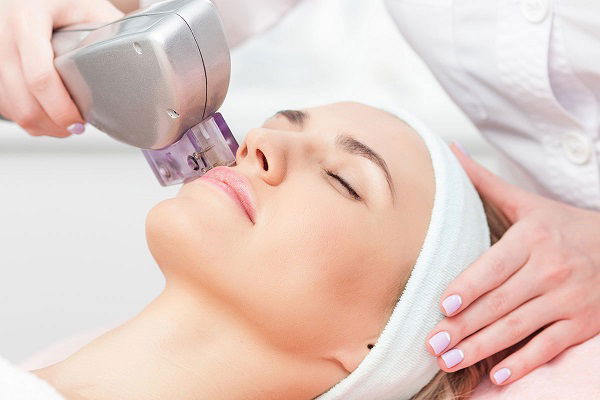What are the benefits of laser skin resurfacing?
Laser skin resurfacing is a cosmetic procedure that uses laser technology to improve the appearance of the skin by reducing wrinkles, fine lines, sun damage, and uneven texture. It works by removing the outer layer of damaged skin, stimulating the collagen production, and promoting the growth of new and healthier skin cells.

During laser skin resurfacing in Dubai, a device is used which emits short, concentrated beams of light that target the specific areas of the skin being treated. There are two main types of lasers used in this procedure:
ablative and non-ablative lasers.
• Non-ablative lasers: These lasers work by heating the underlying layers of the skin without removing the outer layer. They stimulate collagen production and promote skin tightening. Non-ablative lasers have a shorter recovery time but may require multiple sessions to achieve desired results. They are often used for milder skin issues, such as fine lines and mild sun damage.
• Ablative lasers: These lasers remove thin layers of skin by vaporizing the damaged tissue. They are more aggressive and provide more significant results but require a longer recovery time. Ablative lasers are commonly used for more severe skin issues, such as deep wrinkles, scars, and uneven pigmentation. Laser skin resurfacing can be performed on various areas of the body, including the face, neck, chest, and hands.
Treatment Procedure
The procedure for laser skin resurfacing typically involves the following steps:
• Consultation: You will have an initial consultation with a Board Certified Dermatologist or Plastic Surgeon to discuss your specific concerns, goals, and medical history. They will assess your skin condition and determine if laser skin resurfacing is suitable for you.
• Preparations: On the day of the procedure, your skin will be cleansed thoroughly, and a numbing cream or local anesthetic may be applied to minimize discomfort during the treatment.
• Eye protection: To shield your eyes from the laser, you and your Practitioner will wear protective goggles.
• Laser treatment: Depending on the type of laser used, the procedure will differ as explained below:
- Ablative laser: The Practitioner will use a laser device to precisely remove the outer layer of damaged skin. The laser energy will heat the tissue thus causing it to vaporize. This process stimulates collagen production and helps to resurface the skin. The laser is moved across the treatment area, targeting specific problem areas.
- Non-ablative laser: The laser device is passed over the treatment area, delivering controlled heat to the deeper layers of the skin. This process also stimulates collagen production and promotes skin tightening and rejuvenation. Non-ablative lasers do not remove the outer layer of skin.
• Cooling and post-treatment care: After the laser treatment, the Provider may apply a cooling agent or use a cooling device to soothe the treated area. They might also apply ointments or dressings to protect the skin and promote healing. You will receive instructions on how to care for your skin during the recovery period, including avoiding sun exposure and using gentle skincare products.
• Recovery: The recovery time can vary depending on the depth of the treatment and the type of laser used. It can range from a few days to a couple of weeks. During this time, the treated skin will appear red, swollen, and sensitive. It is crucial to follow the post-treatment instructions provided to you and attend any scheduled follow-up appointments.
What to Expect?
Laser skin resurfacing can provide several benefits, including:
• Reduction of wrinkles and fine lines: Laser treatment can help smooth out wrinkles and fine lines on the face, especially those caused by sun damage and ageing. By removing damaged skin and stimulating collagen production, laser resurfacing promotes a smoother and more youthful complexion.
• Improvement in skin texture and tone: Laser treatment can address uneven skin texture and tone, including roughness, scarring, and pigmentation irregularities. It can help minimize the appearance of acne scars, age spots, sun spots, and other skin imperfections, leading to a more even and refined skin surface.
• Skin tightening: Laser skin resurfacing stimulates collagen production, which helps to tighten and firm the skin. This can result in improved elasticity and a reduction in sagging skin, thus giving a more lifted and youthful appearance.
• Reduction of sun damage: Laser treatment can effectively target and reduce the signs of sun damage, such as sunspots, freckles, and discoloration caused by prolonged sun exposure. It can restore a more even and radiant complexion.
• Overall skin rejuvenation: Laser skin resurfacing promotes the growth of new, healthier skin cells, leading to an overall rejuvenation of the skin. The procedure can give your skin a fresher, brighter, and more youthful appearance.
It is important to note that the results of laser skin resurfacing can vary depending on factors such as the individual's skin condition, the type of laser used, the depth of the treatment, and the number of sessions. It is essential to have realistic expectations and discuss your goals with your Provider who can assess your specific needs and guide you through the treatment process.
Need Help?
If you are interested in seeking advice or knowing more about laser surfacing in Dubai, feel free to contact the Al Shunnar patient care team. Our coordinators will readily schedule a personal consultation session for you with one of our Certified practitioners.



